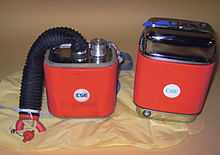Self-contained self-rescue device
From Wikipedia, the free encyclopedia

Two CSE SR-100 SCSRs in the opened (left) and unopened (right) states.
Some SCSRs use potassium superoxide as a chemical oxygen source.
Faulty SCSRs were implicated in the Sago Mine disaster.
See also
- Personal Egress Air Packs
References
- ↑ Stay Calm and Stay in the Cab! (Videotape) (in English). Mine Safety and Health Administration. 1999. Event occurs at 7m21s. DVD544-S. Retrieved 2013-08-04. "(In) each dozer on the job we have a self-rescuer that's located in a compartment directly above the operator's head."
| |||||||||||||||||||||||||||
This article is issued from Wikipedia. The text is available under the Creative Commons Attribution/Share Alike; additional terms may apply for the media files.